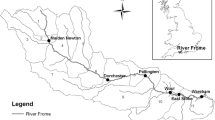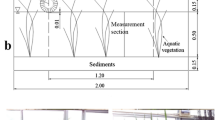Abstract
This study was designed to quantify and model the effects of macrophytes on phosphorus retention in a lowland river. The seasonal course of phosphorus retention was calculated from the measured difference in TP between beginning and end of a 30-km river course and the estimated lateral P input. The coverage of submersed macrophytes was mapped and coincided with the difference between theoretical water level (without vegetation) and the observed one. Therefore, the increase in water level was used as measure of the macrophytes’ abundance. In years with rare vegetation (1991–1994), P was retained in winter and remobilized in summer. In years with dense stands of macrophytes (1995–2002), net P retention was highest in summer and amounted up to 20% of TP load, and was negative during winter. The annual P budget was close to zero in both periods. The found sinusoidal annual pattern of total phosphorus retention was used to create a retention model for vegetated lowland rivers.
Similar content being viewed by others
References
Behrendt H. and Opitz D. (2000). Retention of nutrients in river systems: dependence on specific runoff and hydraulic load. Hydrobiologia 410: 111–122
D’Angelo D. J., Webster J. R. and Benfield E. F. (1991). Mechanisms of stream phosphorus retention: an experimental study. Journal of the North American Benthological Society 10: 225–237
Driescher E. and Gelbrecht J. (1993). Assessing the diffuse phosphorus input from subsurface to surface waters in the catchment area of the lower River Spree (Germany). Water Science & Technology 28: 337–347
Fischer H. and Pusch M. (2001). Comparison of bacterial production in sediments, epiphyton and the pelagic zone of a lowland river. Freshwater Biology 46: 1–14
Köhler J., Bahnwart M. and Ockenfeld K. (2002). Growth and loss processes of riverine phytoplankton in relation to water depth. International Revue of Hydrobiology 87: 241–254
Madsen J. D., Chambers P. A., James W. F., Koch E. W. and Westlake D. F. (2001). The interaction between water movement, sediment dynamics and submersed macrophytes. Hydrobiologia 444: 71–84
Mulholland P. J., Newbold J. D., Elwood J. W. and Ferren L. A. (1985). Phosphorus spiralling in a woodland stream: seasonal variations. Ecology 66: 1012–1023
Newbold J. D., Elwood J. W. and O’Neill R. V. (1981). Measuring nutrient spiralling in streams. Canadian Journal of Fisheries and Aquatic Sciences 38: 860–863
Reddy K. R., Flaig E. G. and Graetz D. A. (1996). Phosphorus storage capacity of uplands, wetlands and streams of Lake Okeechobee Watershed, Florida. Agriculture, Ecosystems and Environment 59: 203–216
Sand-Jensen K. (1998). Influence of submerged macrophytes on sediment composition and near-bed flow in lowland streams. Freshwater Biology 39: 663–679
Schulz M. and Gücker B. (2005). Macrophytes increase spatial patchiness of fluvial sedimentary records and evoke temporal particulate nutrient storage. Aquatic Geochemistry 11: 89–107
Schulz M., Kozerski H. -P., Pluntke T. and Rinke K. (2003a). The influence of macrophytes on sedimentation and nutrient retention in the lower River Spree. Water Research 37: 569–578
Schulz M., Rinke K. and Köhler J. (2003b). A combined approach of photogrammetrical methods and field studies to determine nutrient retention by submersed macrophytes in running waters. Aquatic Botany 76: 17–29
Svendsen L. M. and Kronvang B. (1995). Dynamics of phosphorus compounds in a lowland river system: importance of retention and non-point sources. Hydrological Processes 9: 119–142
Svendsen L. M., Kronvang B. K., Laubel A. R., Larsen S. E. and Andersen B. (1998). Phosphorus retention in a Danish lowland river system. Verhandlungen der Internationalen Vereinigung Limnologie 26: 956–962
Triska F. J., Kennedy R. J., Zellweger G. W. and Bencala K. E. (1989). Retention and transport of nutrients in a third-order stream: channel processes. Ecology 70: 1877–1892
Scheffer M. and Coops H. (2002). Aquatic macrophytes: restore, eradicate or is there a compromise?. Aquatic Botany 72: 387–403
Author information
Authors and Affiliations
Corresponding author
Rights and permissions
About this article
Cite this article
Schulz, M., Köhler, J. A Simple Model of Phosphorus Retention Evoked by Submerged Macrophytes in Lowland Rivers. Hydrobiologia 563, 521–525 (2006). https://doi.org/10.1007/s10750-006-0027-1
Received:
Revised:
Accepted:
Published:
Issue Date:
DOI: https://doi.org/10.1007/s10750-006-0027-1




